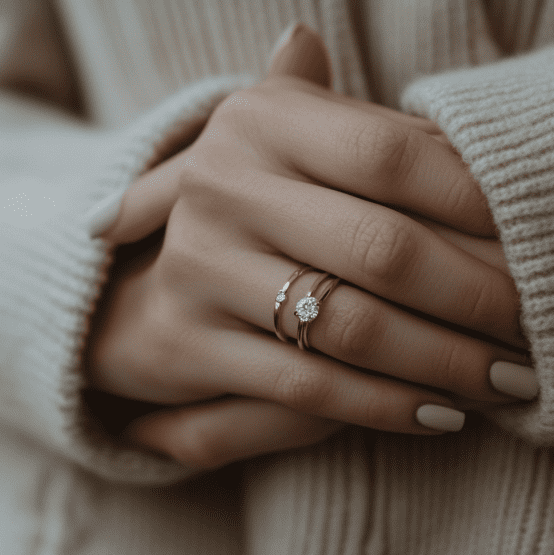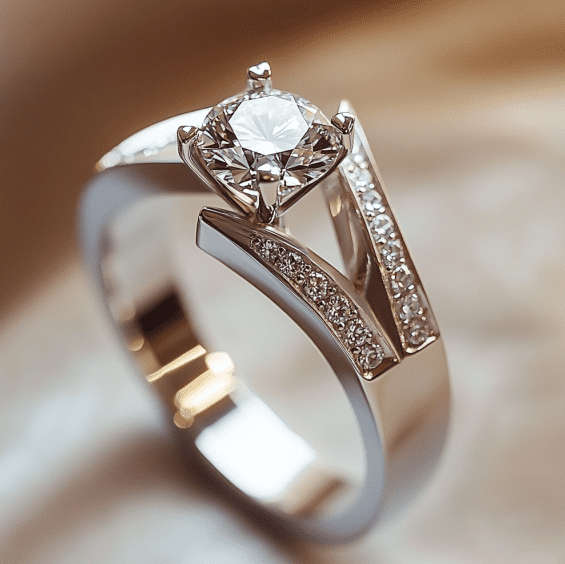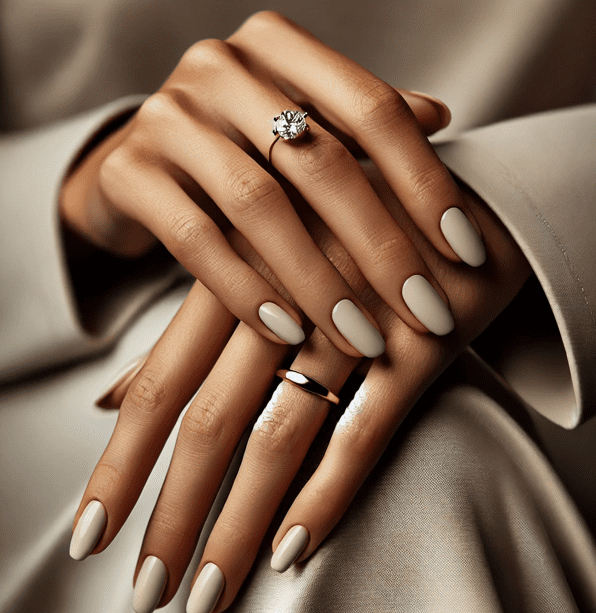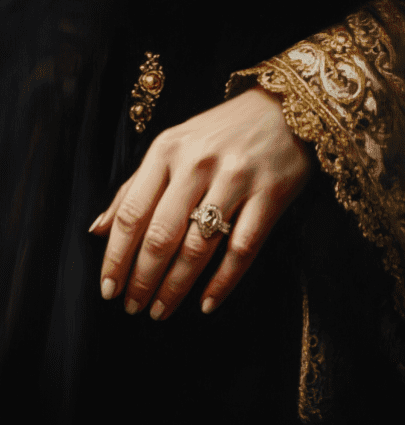Which Hand to Wear the Engagement Ring On
Traditions, Meaning, and Tips
Which Hand to Wear the Engagement Ring On by Culture and Religion
The question of which hand to wear the engagement ring on has no single universal answer, as traditions vary widely by culture, religion, and even personal preference. Throughout history, the engagement ring has symbolized love and commitment, yet its placement on the hand can differ depending on local customs and religious beliefs. Here, we explore how different cultures and religions answer this question and the meaning attributed to each choice.
Western Tradition: The Left Hand as Preference
In many Western countries, such as the United States, the United Kingdom, Canada, and many European nations, the engagement ring is commonly worn on the left hand. This tradition dates back to ancient Rome, where it was believed that a vein, known as the “vena amoris,” connected the left ring finger directly to the heart. Although modern science has disproved the existence of this vein, the tradition has endured through the centuries.
In these countries, after the wedding, the engagement ring is usually kept on the left ring finger, along with the wedding band. This practice is seen as a reflection of the symbolism of carrying love and commitment close to the heart.
Europe and Latin America: The Right Hand is Also Popular
In other European countries, such as Germany, Norway, Russia, and Poland, the answer to which hand to wear the engagement ring on is different. In these places, the engagement ring is typically worn on the right hand. This tradition is also followed in many Latin American countries, including Mexico, Venezuela, Colombia, and Chile.
The reason behind this cultural difference varies, but in general, in these regions, the right hand is associated with righteousness and authority, which can symbolize the strength and value of the commitment made when giving or receiving an engagement ring.

Jewish Culture: Which Hand to Wear the Engagement Ring On
Left Hand Before the Wedding, Right Hand After
In Jewish culture, there is a special tradition that incorporates both hands. During the engagement ceremony, the ring is placed on the index finger of the right hand. The index finger is said to have a symbolic connection to leadership and authority, making it fitting for a significant moment like the giving of an engagement ring.
However, after the wedding, Jewish couples typically move the engagement ring to the left hand, similar to the Western tradition. This change of hands symbolizes the transition from the engagement stage to a permanent union through marriage.
Catholic Traditions: Historical and Regional Influences
In many predominantly Catholic countries, such as Spain, Portugal, and some Latin American countries, the engagement ring is worn on the right hand. This tradition may be influenced by the Catholic Church, which historically associates the right hand with righteousness and justice. In religious ceremonies, placing the ring on the right hand is considered more appropriate due to its connection to the divine.
Interestingly, in other Catholic countries, like France or Italy, the engagement ring is more commonly worn on the left hand, showing how traditions can vary even within the same religion.
Hindu Culture: Dependent on the Dominant Hand
In Hindu culture, the choice of which hand to wear the engagement ring on is often related to the individual’s dominant hand. Traditionally, the right hand is considered the purest and preferred for symbolic and ceremonial gestures. However, in modern times, many Hindu couples prefer to wear the engagement ring on the left hand, as this hand has become globally popular for this purpose.
It’s worth noting that although the engagement ring isn’t a deeply rooted tradition in Hindu customs, it has gained popularity in recent decades due to Western influence.
Islamic Culture: Variability in Choice
In Islamic culture, there is no strict rule about which hand to wear the engagement ring on. Although it isn’t a formal tradition within Islam, many Muslim couples adopt the engagement ring as part of modern engagement and marriage practices. Some choose to wear the ring on the right hand, while others prefer the left, depending on family traditions or the region where they live.
Conclusion
The answer to which hand to wear the engagement ring on depends largely on culture, religion, and personal preference. Whether on the left or right hand, what truly matters is the emotional significance behind this beautiful gesture—a promise of love and commitment between two people. Understanding the different traditions can help you make an informed and respectful decision aligned with the beliefs and customs of your partner or community.
Which Hand to Wear the Engagement Ring On and Its Relation to the Wedding Ring
The use of rings as symbols of commitment and union has a long history, and one of the most common questions that arise during this process is which hand to wear the engagement ring on and how it relates to the wedding ring. Although these traditions may vary by culture and local customs, both rings carry profound and special meaning. Here, we explore the relationship between the engagement ring and the wedding ring, and how their placement on the hands can differ and complement each other in various parts of the world.
- Engagement Ring vs. Wedding Ring: Fundamental Differences
Before diving into which hand to wear the engagement ring on and its relation to the wedding ring, it’s essential to clarify the differences between the two. The engagement ring is a symbol marking the promise of marriage and is typically given when a couple decides to wed. It’s often adorned with a gemstone, like a diamond, and represents the beginning of the journey toward marriage.
In contrast, the wedding ring (or wedding band) is exchanged during the wedding ceremony and symbolizes the eternal union between spouses. This ring is often simpler in design and is worn together with the engagement ring, though this varies according to customs and individual preferences.
- Which Hand to Wear the Engagement Ring On Before Marriage
In many Western countries, such as the United States, Canada, the United Kingdom, and much of Europe, the engagement ring is traditionally placed on the left ring finger. This tradition dates back to the Roman belief in the “vena amoris,” a vein thought to connect the left ring finger directly to the heart, making this finger the ideal place for a symbol of love.
In other parts of the world, such as several Eastern European and Latin American countries, the engagement ring is worn on the right hand. This choice is not arbitrary; in many cultures, the right hand is seen as more honorable or powerful, making it the preferred hand for bearing important symbols like the engagement ring.

- The Wedding Day: What Happens to the Engagement Ring?
On the wedding day, the question arises of what to do with the engagement ring during the ceremony. In many Western cultures, the engagement ring is temporarily moved to the right hand, leaving the left ring finger free for the wedding band. After the wedding band is placed on the left finger during the ceremony, the engagement ring can be returned to the left hand, typically worn alongside the wedding band.
This switch symbolizes the transition from engagement to marriage, with the wedding band taking on greater significance. In other cultures, however, both rings may be worn on different hands, with the wedding band on the right hand and the engagement ring on the left, thus maintaining their individual symbolism.
- How to Wear Both Rings After the Wedding
After marriage, the way both rings are worn can vary significantly. In countries like the United States, Canada, and the United Kingdom, it’s common for people to wear both the engagement and wedding rings on the left ring finger. Typically, the wedding band is placed first, closer to the heart, followed by the engagement ring. This order has symbolic meaning: the wedding band, representing eternal union, should be closest to the heart.
In countries such as Russia, Greece, or Germany, where the wedding band is worn on the right hand, the engagement ring may be worn on the left hand or also on the right, depending on personal preferences. In these cases, the two rings are usually not worn on the same finger but continue to represent the couple’s love and union.
- Cultural and Personal Modifications in Ring Wearing
Today, many couples choose to personalize the way they wear their rings. Some people decide not to wear an engagement ring and focus solely on the wedding band. Others prefer to combine both rings into a single design, creating a unique piece that symbolizes both commitment and marriage.
Additionally, in some cases, a person’s profession or lifestyle can influence which hand the engagement ring is worn on. For example, individuals who work with their hands may choose to wear rings on the right hand or even remove them during the workday to prevent damage.
- The Importance of Symbolism and Personal Meaning
While traditions can provide clear guidelines on which hand to wear the engagement ring on, the most important aspect is the personal meaning that the rings hold for the couple. Whether they choose to follow cultural customs or create new traditions, what matters most is that both rings represent the love, commitment, and unity the couple wishes to symbolize.
Conclusion
The relationship between which hand to wear the engagement and wedding rings on can vary greatly depending on cultural and religious traditions, yet both rings share profound meaning. From the moment of engagement to the wedding ceremony and beyond, the rings symbolize the evolution of the relationship and the eternal love between two people.
Which Hand to Wear the Engagement Ring On in Different Countries
The tradition of wearing an engagement ring to symbolize a promise of marriage is present in many cultures around the world. However, the placement of the ring—specifically, which hand to wear the engagement ring on—varies significantly from one country to another. Customs, religious beliefs, and even cultural influences have shaped these practices. Here, we explore how different countries and cultures answer this question.
- United States and the United Kingdom: Left Hand
In much of the Western world, including the United States and the United Kingdom, the engagement ring is traditionally worn on the left-hand ring finger. This practice originated in ancient Rome, where it was believed that the left ring finger had a vein, known as the “vena amoris” or “vein of love,” that led directly to the heart. Although modern science has disproven this belief, the tradition has persisted.
In these countries, the wedding band is also placed on the left hand during the wedding ceremony, and many people choose to wear both rings on the same finger after marriage.
- Latin American Countries: Right or Left Hand
Traditions in Latin America regarding which hand to wear the engagement ring on vary between countries. In places like Mexico, Venezuela, Colombia, and Chile, the engagement ring is typically worn on the right hand during the engagement period. However, once the couple marries, the wedding band is often placed on the left hand, similar to many Western practices.
In countries like Argentina, the engagement ring is worn on the left hand, and after marriage, it remains on that same hand, alongside the wedding band. These variations reflect the region’s cultural diversity.
- Germany and Eastern European Countries: Right Hand
In Germany, as well as in several Eastern European countries like Poland and Russia, the engagement ring is worn on the right hand. This tradition is associated with the belief that the right hand is the “correct” hand for such an important symbol as the engagement ring, as the right hand in these cultures symbolizes righteousness and authority.
The wedding band is also worn on the right hand after the wedding, reflecting the importance of this symbol in Eastern European culture.

- Spain and Greece: Right Hand
In Spain and Greece, the engagement ring is also worn on the right hand. In these cultures, the right hand is considered the most appropriate for important rituals, such as engagement and marriage. After the wedding, the wedding ring is placed on the right hand, while the engagement ring may or may not be moved to the left.
In Greece, this tradition is deeply rooted in the Orthodox religion, which significantly influences the placement of the wedding ring as well.
Brazil: Right Hand During Engagement, Left Hand After Marriage
In Brazil, one of the most interesting customs regarding which hand to wear the engagement ring on is that it’s worn on the right hand during the engagement period. However, after the wedding, the engagement ring is moved to the left hand along with the wedding ring. This switch symbolizes the transition from engagement to marriage.India: Right or Left Hand, Depending on Religion and Modernity
In India, the tradition of wearing an engagement ring is not as old as in other cultures, but it has gained popularity in recent decades due to Western influence. The choice of which hand to wear the engagement ring on depends largely on religion and dominant hand.
Traditionally, the right hand is considered more auspicious in Hindu religious ceremonies. However, in more modern cities, it’s becoming increasingly common to see couples wearing the engagement ring on the left hand, aligning with Western customs.
Scandinavian Countries: Left Hand for Engagement and Marriage
In Scandinavian countries, such as Sweden, Norway, and Denmark, the tradition is to wear the engagement ring on the left hand. As in many other Western cultures, this originates from the belief in the “vena amoris.” Both the engagement and wedding rings are placed on the left hand and worn together after the wedding.France and Italy: Left Hand, Western Style
In France and Italy, engagement rings are worn on the left hand. Although each of these countries has its own cultural variations and rituals, the practice of wearing rings on the left hand aligns with the customs of the United States and the United Kingdom.Russia and Orthodox Countries: Right Hand
In Russia, as well as in other Orthodox-influenced countries like Ukraine and Serbia, both the engagement and wedding rings are worn on the right hand. The Orthodox Church teaches that the right hand is the correct one for wearing sacred symbols, such as the wedding ring, due to its significance in the Christian faith.Conclusion
As we can see, which hand to wear the engagement ring on varies significantly across different countries and cultures. From the left hand in much of the Western world to the right hand in Eastern Europe and Latin America, local customs and religious beliefs play a crucial role in this decision. However, regardless of which hand it’s placed on, the engagement ring remains a universal symbol of love and commitment.
History of Which Hand to Wear the Engagement Ring On Over Time
The tradition of wearing an engagement ring as a symbol of love and a promise of marriage has its roots in ancient civilizations. From Roman practices to modern customs, the question of which hand to wear the engagement ring on has evolved and adapted across cultures, religions, and societies over time. Here, we explore how this tradition has changed through the ages and the meanings behind the choice of hand for carrying this symbol of love.
- Ancient Rome: The Origin of the Left Hand
The belief that the engagement ring should be worn on the left-hand ring finger dates back to Ancient Rome. The Romans believed that this finger contained the “vena amoris,” a vein that connected directly to the heart. Although modern anatomy has disproven this, the idea of wearing the ring on the finger closest to the heart symbolized eternal love and commitment, giving rise to this tradition.
In addition to the symbolism of the “vena amoris,” the Romans also believed that the engagement ring, made initially of iron and later of gold, represented the strength and durability of the commitment. Over time, the practice of wearing the ring on the left hand spread to other civilizations.
- The Middle Ages: Use of the Ring in Christian Ceremonies
During the Middle Ages, the Catholic Church greatly influenced the practice of which hand to wear the engagement ring on. In Christian wedding ceremonies, priests would often place the ring on the left-hand ring finger of both the bride and groom, following Roman tradition.
The Catholic Church also reinforced the ring’s symbolism, describing it as an endless circle representing the eternity of love and marriage. During this era, engagement rings became common among the noble and wealthy classes, with the use of precious metals and gemstones becoming more prevalent.
- 16th and 17th Centuries: Expansion of the Tradition in Europe
As the influence of Christianity and European monarchies grew, the custom of wearing an engagement ring on the left hand spread across much of Europe. By the 16th century, it became common for noblemen to gift engagement rings as a symbol of their promise of marriage.
However, in some European countries, such as Germany and Russia, the tradition evolved, and the right hand was adopted for wearing the engagement ring. The choice of the right hand was based on the belief that this hand was more honorable and just, making it more appropriate for bearing an important symbol like the engagement ring.

- The Renaissance: A Rise in Ring Design
During the Renaissance, the engagement ring gained even more significance as a symbol of status and commitment. Kings and nobility began exchanging rings adorned with precious stones and rare metals. A famous example is the ring that Archduke Maximilian of Austria gave to Mary of Burgundy in 1477, considered one of the first engagement rings featuring a diamond.
At this time, although the left hand remained the predominant choice for wearing engagement rings in countries like France, Spain, and England, the right hand continued to be preferred in regions of Eastern Europe.
- The 19th Century: Popularization of the Engagement Ring
The 19th century brought the Industrial Revolution, making engagement rings accessible to more people beyond the upper classes. The tradition of which hand to wear the engagement ring on became established in much of Europe and the United States, with the left ring finger solidifying as the standard.
However, in countries like Germany, Norway, and Russia, the right hand remained the preferred choice due to religious and cultural influence. This duality in hand choice reflected both Roman tradition and the evolution of local beliefs.
- 20th and 21st Centuries: Diversification and Modern Preferences
In the 20th century, globalization and cultural exchange began to influence engagement traditions. In many countries, the choice of which hand to wear the engagement ring on became more flexible, with some people adopting customs from other cultures. For example, in Latin America, it’s common to wear the engagement ring on the right hand until the wedding, when it’s moved to the left hand alongside the wedding band.
In the 21st century, this flexibility has become even more pronounced. Many couples choose to personalize their engagement and wedding experience, selecting the hand they prefer for their rings. Tradition has become more a matter of style and personal preference, while the ring’s symbolism remains unchanged—a promise of eternal love.
Conclusion
The tradition of which hand to wear the engagement ring on has evolved over the centuries, but it has always held its value as a symbol of love and commitment. From Ancient Rome to the present, the choice of hand has been shaped by cultural, religious, and even personal beliefs. Today, this choice can reflect local traditions or individual preference, but it always carries the same meaning of union and promise.
For more information, visit here
